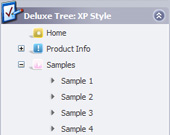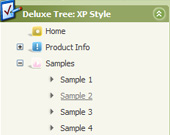Template: Javascript Tree View Windows Explorer Like
Vista Style 5 Dhtml Tree Menu
The template emulates Vista OS menu style. To open submenus click on menu items.
The appearence of this template is determined by the following parameters:
- The menu have XP Style; Animation effect for subitems
- Toggle-mode support.
- Items have icons
- Menu has a static position and is placed within the table cell
The template emulates Vista OS menu style. To open submenus click on menu items.
The appearence of this template is determined by the following parameters:
- The menu have XP Style; Animation effect for subitems
- Toggle-mode support.
- Items have icons
- Menu has a static position and is placed within the table cell
Key features:
- Status string shows item labels
- 3-state icons for each item
- Filters and Transitional effects
- Submenus expand/collapse on mouseover
- Image arrows
- Submenus automatically scrolls
- Personal CSS styles for separate menu elements
- Submenus have a fade effect
- Status string shows item labels
- 3-state icons for each item
- Filters and Transitional effects
- Submenus expand/collapse on mouseover
- Image arrows
- Submenus automatically scrolls
- Personal CSS styles for separate menu elements
- Submenus have a fade effect










